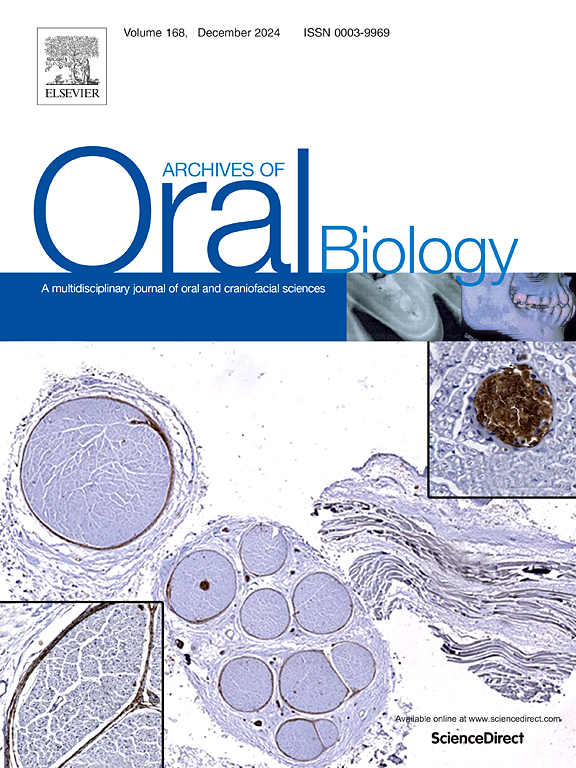Effects of ionizing radiation on osteoblastic cells: In vitro insights into the etiopathogenesis of osteoradionecrosis
IF 2.2
4区 医学
Q2 DENTISTRY, ORAL SURGERY & MEDICINE
引用次数: 0
Abstract
Objective
This in vitro study aimed to analyze the effects of ionizing radiation on immortalized human osteoblast-like cells (SaOS-2) and further assess their cellular response in co-culture with fibroblasts. These analyses, conducted in both monoculture and co-culture, are based on two theoretical models of osteoradionecrosis – the theory of hypoxia and cellular necrosis and the theory of the radiation-induced fibroatrophic process.
Design
SaOS-2 cells were exposed to ionizing radiation and evaluated for cell viability, nitric oxide (NO) production, cellular morphology, wound healing, and gene expression related to the PI3K-AKT-mTOR pathway. SaOS-2 cells were co-cultured with human gingival fibroblasts using transwell membranes and subjected to the same irradiation. Subsequent evaluations included cell viability, NO levels, and gene expression analysis.
Results
After 24 hours, a 16 Grays dose reduced cell viability by 40 % (p < 0.0001) and increased NO production by 14 % (p < 0.05). Additionally, the nuclear area was enlarged by 18 % (p < 0.01), and the nucleus-to-cytoplasm ratio in non-stimulated cells was around 33 %, but after radiation, this ratio increased to nearly 100 %. Also, there was a delay in wound closure of 6.6 % (p < 0.0001) post-irradiation and a trend toward down-regulation of genes related to the PI3K–AKT–mTOR pathway (p > 0.05). Under co-culture conditions, the dose of 16 Grays did not affect cell viability but increased NO production by 14 % (p < 0.001) and tended to up-regulate markers of the PI3K–AKT–mTOR pathway (p > 0.05).
Conclusions
The findings of this study demonstrate that an irradiation dose of 16 Grays induces a reduction in cell viability, an increase in NO production, and various other metabolic and morphologic effects on osteoblastic cells while emphasizing the impact of intercellular interaction in the etiopathogenesis.
电离辐射对成骨细胞的影响:体外观察骨放射性坏死的发病机制。
目的:本实验旨在分析电离辐射对永生化人成骨细胞样细胞(SaOS-2)的影响,并进一步评估其与成纤维细胞共培养的细胞反应。在单培养和共培养中进行的这些分析是基于两种骨放射性坏死理论模型-缺氧和细胞坏死理论以及辐射诱导的纤维萎缩过程理论。设计:将SaOS-2细胞暴露于电离辐射中,评估细胞活力、一氧化氮(NO)产生、细胞形态、伤口愈合以及与PI3K-AKT-mTOR通路相关的基因表达。采用transwell膜将SaOS-2细胞与人牙龈成纤维细胞共培养,并给予相同的辐照。随后的评估包括细胞活力、NO水平和基因表达分析。结果:24 小时后,16次灰毒可使细胞活力降低40% % (p 0.05)。在共培养条件下,16 gray剂量不影响细胞活力,但使NO产量提高了14 % (p 0.05)。结论:本研究的结果表明,16 gray的照射剂量会导致细胞活力降低,NO产生增加,以及对成骨细胞的各种其他代谢和形态学影响,同时强调了细胞间相互作用在发病机制中的影响。
本文章由计算机程序翻译,如有差异,请以英文原文为准。
求助全文
约1分钟内获得全文
求助全文
来源期刊

Archives of oral biology
医学-牙科与口腔外科
CiteScore
5.10
自引率
3.30%
发文量
177
审稿时长
26 days
期刊介绍:
Archives of Oral Biology is an international journal which aims to publish papers of the highest scientific quality in the oral and craniofacial sciences. The journal is particularly interested in research which advances knowledge in the mechanisms of craniofacial development and disease, including:
Cell and molecular biology
Molecular genetics
Immunology
Pathogenesis
Cellular microbiology
Embryology
Syndromology
Forensic dentistry
 求助内容:
求助内容: 应助结果提醒方式:
应助结果提醒方式:


